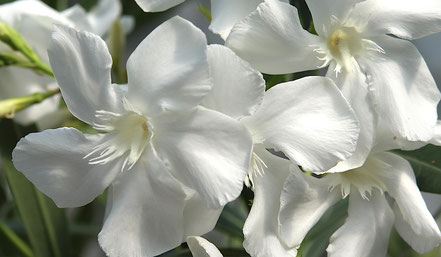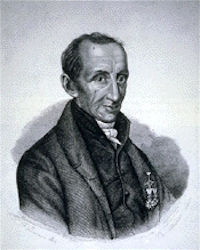- DEUTSCH
- ENGLISH
- SUCHE / SEARCH
In 1547 a white-flowered oleander was discovered on the island of Crete. One can find this or a similar statement in the oleander literature where the history of the oleander is discussed.
Today the oleander is known in many colors and forms, and someone who wishes to specialize can refer to a comprehensive list with precise, catalogued cultivar names. This was not always the case, however. For thousands of years, ever since depictions have existed, only one type of oleander was known – and that was pink and single-flowered (not double). Only toward the end of the 17th century and in the 18th century did different colors, fragrance, and double-flowered forms appear.
However, it is astounding that well before the “Indian Oleander” came to Europe and could be hybridized to create new forms, a white oleander was suddenly discovered on the island of Crete and in fact precisely dated 1547. The location of the discovery was in the White Mountains in the region of Camerachi near Candia (today Astyraki near Iraklion). But who were the people, what was the time like?
We find ourselves in the second half of the 16th century. It was not that long before that book printing was invented. An explosion of knowledge has occurred, and the needs of the new universities must be satisfied. We are experiencing the heyday of the Renaissance in science, philosophy, and mathematics; in art, sculpture, architecture, and painting. It is the time of Michelangelo and Da Vinci. Scholars, and therefore also botanists, initially copied, transcribed, and translated everything which was available in the “Old Writings” of the ancients – in the sense of turning to antiquity and its cultural achievements. And, as in all disciplines, including our own – botany – they added new knowledge. This was done by means of texts, descriptions, and drawings, through observations, traveling, planting of gardens – and money from wealthy sources, aristocratic or royal patrons, or shrewd entrepreneurs.
However, it was also the era of the plague; we read of at least two scholors who succumbed to it. The so-called “Little Ice Age” (15th – 19th centuries) was marked during the 16th century and favored the spread of the plague. Cooler seasons, rainy summers, poor harvests, and vermin – all of these led to suffering, especially among farmers and “common people”.
It was under these cultural, intellectual, and climatic conditions that the ”White Oleander” turned up – a new phenomenon. How interesting that is! Precisely then – not earlier and not later. It was the just the right time, the right epoch. It was, so to speak, a window of time. It was only a few decades from its discovery to its widespread distribution. It would not have been possible previously; the conditions were not right. A few decades later, with the appearance of the “Indian Oleander” the “White Oleander” would have disappeared or might not even have been noticed, as the others were more spectacular.
Thus, it is really high time – 500 years after its discovery! – that we follow the trail of the “White Oleander” more closely. And who were the people who saw in it something so special that it spread all over Europe in just a few decades – before the varicolored, fragrant, or double oleanders (initially called “Indian”), became known? It was Carl von Linné who first cleared up the relationship between the two types and established with his new nomenclature that there was only one species of oleander – but that was not until the 18th century, 200 years later.
Let’s embark, therefore, upon the trail of discovery, in order to understand that the “White Oleander” – the “Pure White Oleander” – is something special perhaps even in our time.
F. J. J. Pagen
Franz W. Sieber
1789-1844
Gaetano Savi
1769-1844
Luca Ghini
1490-1556
Ulisse Aldrovandi
1522-1605
John Gerard
1545-1612
Pietro Andrea Mattioli 1501-1577
Matthias de L’Obel 1538-1616
Pietro Antonio Michiel 1510–1576
Pierre Belon
1517–1564












